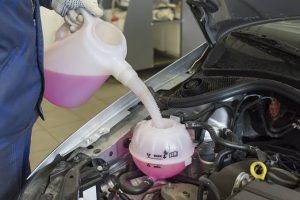It is winter and the weather conditions are getting colder every day. You must get the best antifreeze for car to enhance its performance and overall well-being.
But what is Antifreeze for car? How do you know the best antifreeze color for your car, what is the importance of antifreeze in a car, and what is the purpose of car coolant?
All these and other questions are what we shall be discussing in this article. Hence, we advise you pay concrete attention as we proceed.
Contents
What Is Antifreeze
Antifreeze is a colored liquid that regulates engine temperature during cold temperatures. It also helps in preventing overheating.
In other words, antifreeze is a chemical solution made from ethylene glycol, which lowers the freezing point of water in your car during a cold period.
In an extremely cold temperature that might affect the engine, the coolant is produced via the engine block to regulate and moderate the temperature.
Also known as coolant, antifreeze must be diluted with water before use so it can function as a coolant to prevent overheating, and as antifreeze to prevent freezing.
Type Of antifreeze colors
Almost everyone knows the two major antifreeze colors to be Green and Orange, but there are more coolant colors.
Other antifreeze colors aside green and orange are red, pink, yellow, blue, turquoise, and purple.
Meanwhile, your reason for antifreeze, your vehicle model, and how often you intend to change your coolant are things to consider while choosing the antifreeze for your car.
Can you mix different colors of antifreeze?
No, you can’t mix different antifreeze because each has unique chemical compositions. Mixing two or more coolants will cause an unfavorable chemical reaction that could lead to gel-like substances preventing the engine from working adequately.
Can you mix yellow and green antifreeze?
No. You can’t mix antifreeze of different colors. You are to stick with the same color if there is any reason to mix coolants.
Is yellow antifreeze the same as green?
No. They are antifreeze with different attributes. Though they perform almost the same functions, you can’t mix them.
Yellow antifreeze belongs to the Hybrid Organic Acid Technology category which should be flushed out of your engine every 5 years.
As for the green antifreeze, it belongs to the Inorganic Acid Technology (IAT) antifreeze that can last for just two years in your vehicle.
What happens if you use the wrong color antifreeze?
Using the wrong color antifreeze can reduce the performance of the special additives in the coolants, thereby leading to increased corrosion to the radiator.
It could also lead to the destruction of the water pump, radiator hoses, cylinder gasket, and the whole engine at large.
Using the wrong color antifreeze can equally cause the vehicle’s cooling system to become thinner and very porous.
What color is universal antifreeze?
Though there are numerous types of antifreeze colors, the Green Inorganic Acid Technology (IAT) is widely referred to as the universal coolant by vehicle experts and owners.
What happens if you don’t dilute antifreeze?
As mentioned earlier, antifreeze must be mixed with water in 50/50 proportion for better effectiveness.
If you don’t dilute your antifreeze, your engine could experience overheating as there isn’t enough water to pull the heat.
In terms of the cooling effect, adding pure antifreeze will prevent the system from freezing. But the system is prone to get heated up in no time which might affect the engine in the long run.
Importance Of Antifreeze
Apart from moderating the temperature, the antifreeze performs other functions including the following:
- It helps to provide a good working condition for the engine.
- It prolongs the engine’s lifespan as it lowers the level of damage caused by freezing.
- It helps to increase the performance of your car.
- It serves as anti-corrosion
- It prevents deposits that could affect the engine.
- It serves as anti-foam.
Types of Antifreeze
There are many types of antifreeze categorized into three main types which are represented by different colors. The three main types of antifreeze are:
1. Inorganic Acid Technology (IAT)
This antifreeze has a light green color pigment and it is made up of silicates and phosphate corrosion inhibitors which enhance coolant’s ability to protect engines and radiators from rusting easily.
Inorganic Acid Technology (IAT) is widely used in old American-made cars and you must flush it out of your car every two years.
2. Organic Acid Technology (OAT)
This type of antifreeze exists in different colors such as orange, bright red, red, blue, and dark green.
Unlike the Inorganic Acid Technology (IAT), it doesn’t possess silicates or phosphates but that doesn’t stop it from performing its function over a long time.
OAT comprises some additives which ensure that the metal parts of your car don’t rust too easily. The Organic Acid Technology coolant should be flushed out of your car every 10 years or once it covers 135,000 miles.
You are advised to use OAT antifreeze in new GM, VW, Honda, Mitsubishi, Nissan, or Toyota cars.
3. Hybrid Organic Acid Technology (HOAT)
This isn’t a unique type of antifreeze because you need to mix two of the listed antifreeze to get this one.
Since you need to mix IAT and OAT coolants to get this type of antifreeze, many people often say that “there are two types of coolants”.
HOAT coolant boasts of silicates and other important additives that increase aluminum protection and prevents rust and corrosion.
Despite being a mixture of the main coolants, HOAT antifreeze doesn’t possess stronger effectiveness than the rest. It should be changed or flushed out of your vehicle once it reaches 5 years
Conclusion
You might be wondering about which type of coolant is good for your car, it is best and safe you go for the antifreeze specified by the vehicle manufacturer.
Sources

